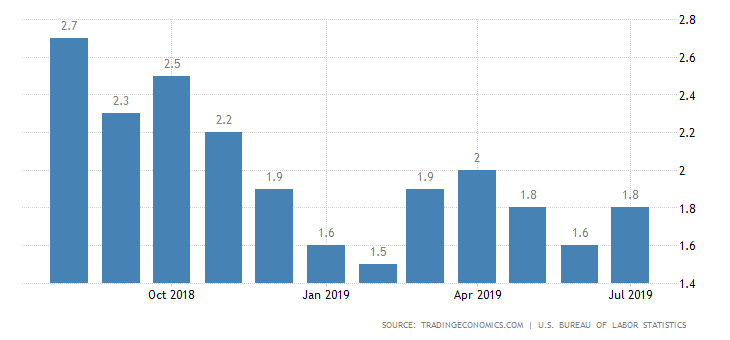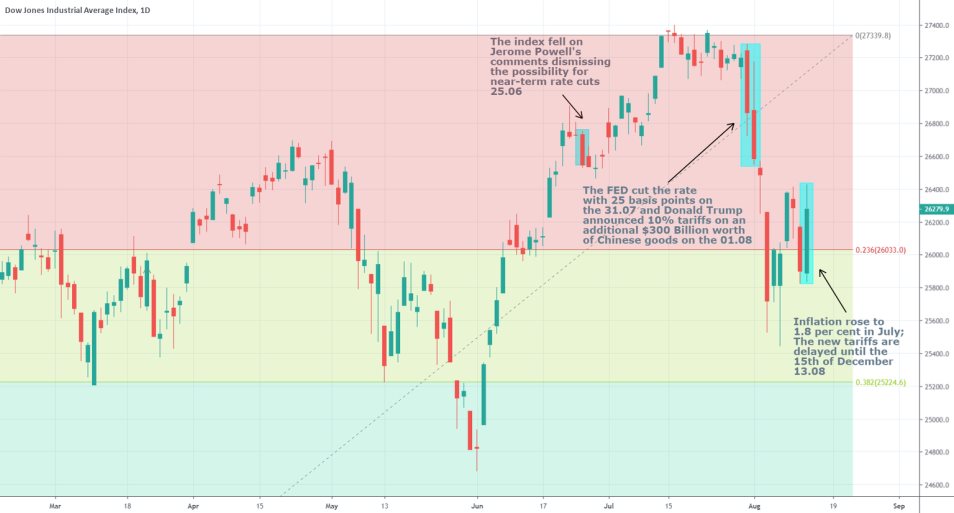The Bureau of Labor Statistics in the United States reported a monthly gain in the CPI with 0.3 per cent for the month of July, which in turn resulted in a rising inflation rate over a 12-month period before seasonal adjustment to 1.8 per cent, from the previous rate of 1.6 per cent for June.

In the report, it is further stated that the most significant contributing factors to the spiked CPI data are noticeable increases in gasoline and shelter indexes [source]. The sudden rise in overall inflation, close to the 2 per cent symmetrical target of the Federal Reserve, was undoubtedly unexpected to occur so soon after the sharp tumble in June, which is subsequently going to make the job of the FED even less straightforward in the following months.
The FED cut the interest rate with 25 basis points on the 31st of July, which was the first reduction of the federal rate in over a decade (we have dedicated an entire article on the subject, underpinning all of the relevant information regarding the FOMC’s decision, and also exposing the likely future ramifications for the US economy. You can read it here.
Following the decision, Donald Trump has expressed his concerns regarding the intentional devaluation of the Yuan by the Chinese central bank, which is giving the world’s second-largest economy a competitive advantage over American exporters, and is the prime reason for Trump’s additional demand for the FOMC and Jerome Powell to reduce the federal funds rate even more, in order to deny China, the advantage. The currency war, however, might not go according to Trump’s plans, as additional reductions by the committee now seem unlikely, as that might drive the inflation to spiral out of control.
Jerome Powell has already argued that the FED, in general, is monitoring the economic situation in the states as it develops and that the FOMC remains open to implementing whatever policies are necessary in order to achieve the committee's goals. This implies that the chairman and his colleagues are not afraid to change their monetary stance frequently, given the extremely volatile economic conditions at the current time. Thus, at the present rate, an interest rate hike by the end of the year seems more likely than a rate cut, given the rising inflation and strong labour conditions.
The Dow Jones Industrial Average finished the trading day with a 1.48 per cent total gain, by breaking above the fundamentally important 23.6 per cent Fibonacci retracement level at 26033.0, and eventually closing at 26279.9.

Trendsharks Premium
Gold is undergoing a correction, as investors take profits to offset losses from falling stock prices, impacting their margins. However, we anticipate a renewed wave of [...]
The Swiss stock market index is mirroring its global counterparts, such as Germany 40 and US100, experiencing a sharp decline following the announcement of new [...]
We’re analyzing the weekly chart to grasp the broader market trend. Over the past three years, the US30 index has surged by 17,000 points, often resembling a nearly straight [...]
Over the past week, the DAX has experienced a sharp decline, plunging by an astonishing 3,400 points. This downward movement is not isolated, as its international counterparts, such as the UK100 and US100, are also facing significant [...]
EURUSD recently formed a double top at 1.0930, signaling a potential trend reversal, and has since begun a correction. After a 600-pip rally since early March, a pullback at this stage is both expected and healthy. Given these conditions, we are placing a [...]
Since early March, EURJPY has surged nearly 1,000 pips, providing us with several excellent trading opportunities. However, as the rally matures, many early buyers are beginning to take profits, leading to a noticeable slowdown in the uptrend. On Friday, the pair formed a [...]
The AUDJPY currency pair continues to be dominated by bullish momentum, as multiple golden cross patterns reaffirm the strength of the ongoing uptrend. Despite this, we are witnessing a much-needed [...]
The EURAUD currency pair appears to be undergoing a trend reversal, signaling a potential shift in market direction. A notable technical development is the formation of a Death Cross on the chart, a widely recognized bearish indicator that typically suggests a [...]
After securing an impressive 200-pip profit last week, the EURJPY currency pair is now undergoing a southward correction, retracing some of its recent gains. Despite this temporary pullback, the Golden Cross remains intact, reinforcing our view that the overall trend continues to be [...]
The appearance of a Golden Cross in Silver strengthens our analysis that the metal is currently in a strong uptrend, indicating further bullish momentum in the market. This technical pattern, where the short-term moving average crosses above the [...]
This trade presents a considerable level of risk and can be classified as an opportunistic move based on recent price action. The GBPUSD currency pair has experienced a substantial bullish rally, surging by nearly 500 pips in a strong upward movement. However, after this extended period of appreciation, the pair is showing signs of a potential [...]
The anticipated Death Cross on the SMI20 appears to be failing as price finds strong support at the 23% Fibonacci retracement level. After testing this area, the index has shown bullish strength, printing several large green candles, signaling an increase in [...]
A Golden Cross has just appeared on the USDJPY chart, signaling a potential bullish move. This technical pattern occurs when the 20 period moving average crosses above the 60 period moving average, a widely recognized indication of increasing [...]
After 2 months of a down trend, we finally see some indications of price recovery for Oil. The golden cross, a historic buy signal, supports this [...]
For the past month, the German DAX40 has experienced a remarkable 10% surge, reflecting strong bullish momentum. Despite ongoing market volatility and frequent pullbacks, every dip continues to attract fresh buyers, reinforcing the [...]
Oil continues its downward trajectory, despite occasional pullbacks. The overall trend remains bearish, reinforced by multiple Death Cross patterns, a classic sell signal indicating further weakness. Adding to this bearish outlook, the critical [...]
Over the past few days, gold has experienced a sharp decline of more than $100. This downturn can be attributed in part to traders securing profits to manage their margins, which are under strain due to the significant drop in major indices. Currently, gold has fallen below the [...]
The NASDAQ 100 index is showing strong bullish momentum, as evidenced by the formation of a Golden Cross on the chart. This classic buy signal occurs when the short moving average crosses above the long term moving average, suggesting that upward momentum is [...]
The EURAUD currency pair has encountered a significant resistance level, failing to break above the critical 61% Fibonacci retracement level. This suggests that bullish momentum is weakening, reinforcing the case for a potential downward move. Given this technical setup, we favor entering a [...]
The UK100 is experiencing a remarkable rally! Over the past few weeks, the British stock market index has surged nearly 800 points. Each minor dip has attracted more buyers, fueling the bullish momentum. However, since last week, we’ve observed a slight [...]




















